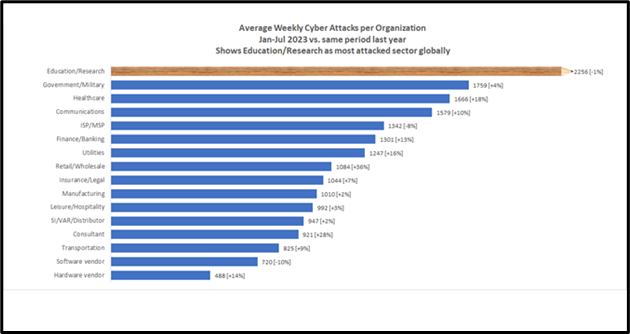
With the education and research sectors being the early adopters of digital platforms for delivery of course material and conducting exams, digital transformation has been an on going process for quite some time. As a result of these digital transformations it has also made them prime targets for cyber attacks.
Check Point Research’s latest report shows that both the education and research sectors experienced the most cyber attacks compared to other sectors. There is such a large disparity between the education and research sectors. 2023 saw on average 2,256 cyber attacks per company.
This shows a slight decrease of 1% compared to the same period in 2022. Even though there was a slight decline in attacks in the education and research sectors, it still experiences the highest rate of cyberattacks amongst all industries which is a significant contrast.
What Is The Reason Behind This Growing Trend?
From the data above it clearly shows that the education and research sectors are the most popular with malicious threat actors. two questions
1) What reasons are there behind the trend?
2) Why are the education and research sectors preferred over others?
One cause my be due to the sectors heavy adoption and use of digital platforms for various uses such as studying, teaching and taking tests.
As a result of the adoption of such platforms, this now gives malicious threat actors plenty of opportunities to exploit as well as amplify the attacks they carry out.
Another reason is that educational institutions store large amounts of sensitive student information. This information includes both personal and financial records which makes them prime targets for malicious threat actors.
In May 2023 reports surfaced that a number of US schools, colleges, & universities had been hit by ransomware attacks which caused major disruptions.

How Do Various Regions Compare?
The APAC region in 2023 recorded the highest number of weekly cyber attacks per educational institutions averaging weekly 4,529 attacks.
Europe had the highest change compared to 2022, with attacks increasing by 11% year on year.
How To Stay Protected Against Cyber Attacks?
- Educate & Train
- It is essential to train and educate your employees so that they can take the necessary steps to prevent a breach from taking place.
- Robust Data Backups
- A robust and secure data solution is a must have and a great way to mitigate any impact of ransomware attacks.
- With systems that are regularly backed up, any data that is lost to a ransomware attack should be minimized or non existent.
- It is essential to ensure that any data backups cannot be encrypted as well if a system is compromised with ransomware.
- Latest Patches Installed
- Ensuring ones computer and respective software is kept up to date with the latest security patches, in particular the critical ones, can help to reduce an organizations proneness to ransomware attacks. Sadly Patches are missed or delayed too long to be able to provide the necessary protections against attacks.
- Anti Ransomware Solutions
- Such solutions monitor what is running on a machine for any suspicious behavior that is commonly displayed by ransomware. If such behaviors are observed, the program can take action to limit the files that are encrypted before further damage is done.
- Use Better Threat Prevention
- Automated threat detection and prevention is a must to maximize your organizations chances to be protected. IT is interesting to note that most of the ransomware attacks we hear about could most likely be detected before its too late.
Anyone that clicked on the application link was taken to a look a like website where the criminals captured the data and personal details of those people.
Several cyber security vendors put out timely alerts on the malicious website which could have potentially stolen a users data as well as performed fraudulent transactions on other websites.

Leave a Reply